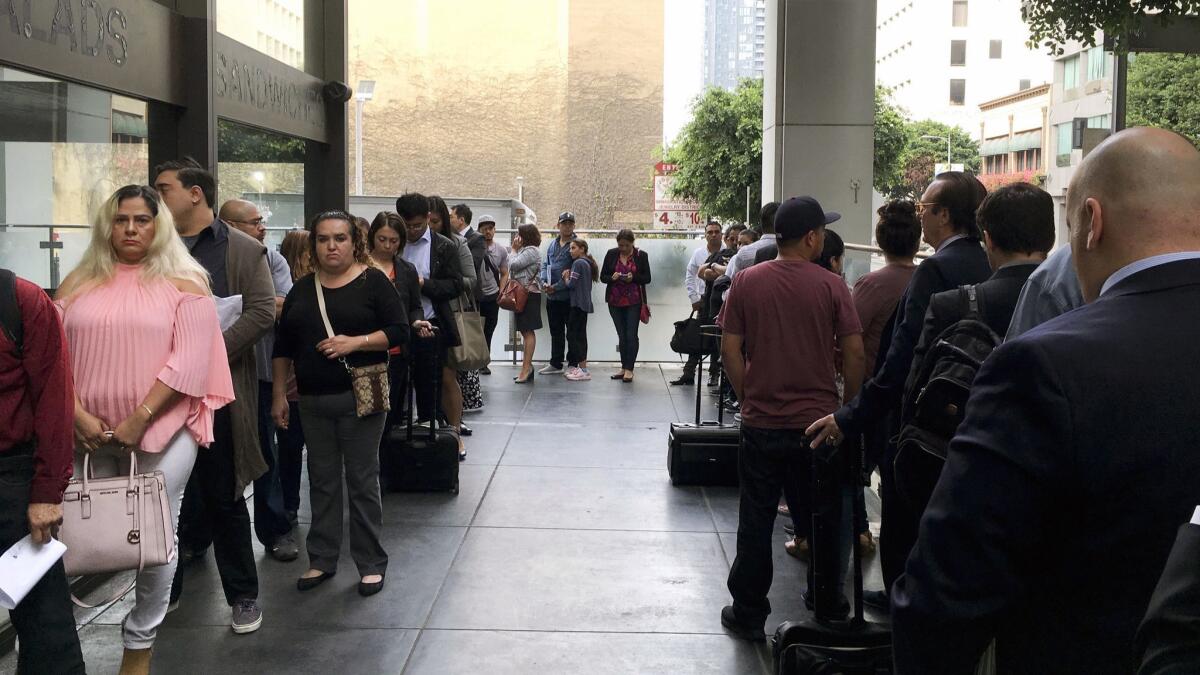Column: New Supreme Court decision could upend thousands of deportation cases in setback for immigration hard-liners

On the 17th floor of Los Angeles Immigration Court the other day, Judge Lori Bass was setting hearings for juveniles who have been charged by the Department of Homeland Security with violating immigration law.
Teenagers and their attorneys sat quietly on rows of hard wooden benches in the windowless room, fidgeting, sighing, waiting. Their attorneys sat with stacks of files in their laps, peering at their phones.
This was nothing like the terrible images of the last month. This was not about bereft parents and tearful children who have been ripped apart at the border. It was a quiet, orderly process. But something dramatic was unfolding here nonetheless. In the avalanche of news about family separations and an upholding of President Trump’s revised Muslim ban, this blow to the administration’s immigration policy seemed to have gotten lost.
One by one, Bass called up young respondents and their attorneys. Each immigrant — mostly young men — put on a headset to hear the interpreter, a middle-aged man, who spoke quietly into a microphone.
The judge began each case by addressing the young men, all of whom are fighting to stay in the country.
“Hi, Jose. How are you? How old are you? Jose, your next hearing is April 13, 2019. Do you understand?”
Much of her conversation with attorneys was lost on me — she spoke in acronyms and legal shorthand — TVPRAs, I-360 status. One puzzling phrase kept coming up.
“Do you plan to file a Pereira motion?” she asked each lawyer. “I’m not telling you what to do, I am just asking.”
I followed an attorney into the hallway.
“What’s a Pereira motion?” I asked Michael Moini, 34, who practices immigration law in Koreatown and was scheduled Tuesday to represent clients at four hearings.
It’s a new U.S. Supreme Court decision, he told me, that may have the potential to upend thousands of deportation cases now snaking through American immigration courts.
Last month, in Pereira vs. Sessions, the court ruled 8 to 1 that the government has been sending invalid “notices to appear” to immigrants facing deportation. The notices are defective, the court said, because they didn’t include a date, time or place.
“It’s like if someone was suing you for a million dollars and you never got a copy of the lawsuit,” Moini said. “Only this is worse. It’s about deportation.”
Attorneys are beginning to file Pereira motions, even though no one is quite sure how courts will interpret the Supreme Court ruling. Will it apply only to those who have been in the country long enough to ask that their deportations be suspended, or will there be larger implications?
“We immigration lawyers may be able to use Pereira to achieve justice in some individual cases, and until its effects get clarified, I would expect it to come up in a large number of cases,” said Chuck Roth, director of litigation for the National Immigrant Justice Center, which filed a friend-of-the-court brief in the case. “But at this point, I wouldn’t want to suggest that the actual effects of the decision will be sweeping. That said, there certainly is a bit of ironic pleasure in the court finding that DHS’s method of service was unlawful for all these years.”
A spokesman for the Justice Department said his office would have no comment on the case.
Nora Phillips of Al Otro Lado, a nonprofit immigration law firm that represents noncitizens fighting to stay in the U.S., many of whom are seeking political asylum, said that last week in court, she tried to invoke Pereira to invalidate the previous deportation of a client who is in deportation proceedings again.
“I’m going to argue that ICE reinstated an order that was flawed from the beginning,” she said. The deportation, she said, “is ‘fruit of the poisonous tree.’”
The judge in the case did not accept the motion, Phillips said, but she is undaunted.
“It’s not a stretch at all,” she said. “It’s a solid argument.”
::
In 2000, Wescley Pereira arrived in the United States from Brazil on a six-month visa. He overstayed that visa, and for 16 years, he worked as a handyman on Martha’s Vineyard, becoming a valued member of the community. He has two children, both U.S. citizens.
In 2006, he was arrested for driving under the influence, which brought him to the attention of immigration authorities who later served him with a “notice to appear” in immigration court that said the date, time and place were “to be set.”
By the time the date, time and place were set, a year later, a notice was sent to him, and it was returned by the post office as “undeliverable.” Without his knowledge, a hearing took place and he was ordered to be removed in absentia.
In March 2013, he was pulled over for driving without his headlights on and was turned over to the Department of Homeland Security for deportation.
Because he had already lived in the U.S. for more than 10 years, was a responsible member of the community and had committed no serious crimes, he was eligible to apply to have his deportation rescinded.
The government, however, argued that the clock on his illegal stay in the country had been stopped in 2006, the year he was served the original notice to appear. For legal purposes, the government claimed, he had been in the country only from 2000 to 2006, six years instead of the requisite 10.
The U.S. Supreme Court didn’t come right out and call that argument preposterous, but it might as well have.
“Common sense compels the conclusion that a notice that does not specify when and where to appear for a removal proceeding is not a ‘notice to appear’ that triggers the stop-time rule,” wrote Justice Sonia Sotomayor for the majority. “If the three words ‘notice to appear’ mean anything in this context, they must mean that, at a minimum, the Government has to provide noncitizens ‘notice’ of the information, i.e., the ‘time’ and ‘place,’ that would enable them ‘to appear’ at the removal hearing in the first place.”
Without that critical information, she wrote, “the Government cannot reasonably expect the noncitizen to appear for his removal proceedings.”
::
On Tuesday, in immigration court, I am sitting next to a boy from El Salvador. He has a head of unruly black curls, cut short around the sides, and the whisper of a dark mustache on his upper lip. Bass called him up and asked his age. He is 14. He crossed the border by himself two years ago, he tells me later.
The judge says the hearing cannot continue if he does not have a family member with him. He leaves the room to call his mother, who is waiting for him in the car. She’s not coming, he tells his attorney. She has to come, the attorney replies.
She’s afraid of getting deported, the boy says.
She won’t be deported, the attorney says. She needs to get up here.
The attorney says he will file a Pereira motion in this case.
A few minutes later, the mom appears. She tells me she picks vegetables in the Inland Empire. Her son says he wants to be a Marine.
It’s an altogether American immigrant story.
And it’s possible that the Supreme Court has helped paved a way for this boy to serve the country he would like to call home.
More to Read
Start your day right
Sign up for Essential California for news, features and recommendations from the L.A. Times and beyond in your inbox six days a week.
You may occasionally receive promotional content from the Los Angeles Times.







